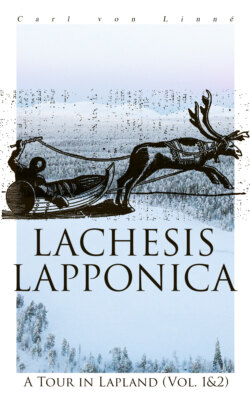Читать книгу Lachesis Lapponica: A Tour in Lapland (Vol. 1&2) - Carl von Linné - Страница 20
На сайте Литреса книга снята с продажи.
May 28.
ОглавлениеI left Teksnas and proceeded to Genom; but as there is no conveyance but by water, from the last-mentioned place to Lycksele, and the wind blew very hard, I was obliged to stop at Genom till the following day. Indeed I did not arrive there till nine o'clock, when I found the people assembled at prayers, after which a sermon was read out of a book containing several; and as this service did not end till eleven, it would then have been too late to have set out for Lycksele, more than five miles distant, without any house or resting-place between.
One of the peasants here had shot a small Beaver. I inquired concerning the food of this animal, and was told it was the bark of trees, the birch, fir, and mountain ash, but more especially the aspen, and the castor becomes larger in proportion as the beaver can get more of the aspen bark. This confirmed the truth of what Assessor Rothman formerly asserted, that castor is secreted from the intermediate bark of the poplar, which has the same scent, though not quite so strong: hence it is to be presumed that a decoction of this bark, if the dose were sufficiently large, would have the same medicinal effects.
I wonder no naturalist has classed this animal with the Mouse tribe, (Mures. Linnæus afterwards called the Order Glires,) as its broad depressed form at first sight suggested to me that it was of that family; in which opinion I was confirmed when I examined the broad naked tail, the short obtuse ears, and the two pair of parallel front teeth, so well formed for cutting, of which the lower pair are the largest.
The people here eat the flesh of the beaver as well as of the hare and squirrel, which indeed are all of the same natural family. The Romans, we are told, ate mice by way of a choice dainty. The beaver is very seldom roasted, but generally boiled. The rump is thrown away, but the feet are eaten. The skin spread out and dried is worth twelve dollars. The castor fetches half a dollar, or sometimes a dollar. I found the boiled flesh very insipid, for want of salt.
This young Beaver, which fell under my examination, was a foot and half long, ex clusive of the tail, which was a palm in length and two inches and a half in breadth. The hairs on the back were longer than the rest; the external ones brownish black, the inner pale brown. The belly clothed with short dark-brown fur. Body depressed. Ears obtuse, clothed with fine short hairs, and destitute of any accessory lobe. Snout blunt, with round nostrils. Upper lip cloven as far as the nostrils; lower very short. The whiskers black, long and stout. Eye-brow of three bristles like the whiskers over each eye. Neck none. The fur of the belly was distinguished from that of the sides by a line on each side, in which the skin was visible. Feet clothed with very short hairs, quite different from those of the body. A fleshy integument invested the whole body. The intestinum cæcum was large, with a very large appendix. Upon the stomach lay two large cellular glands, of whose nature and use I am ignorant. There were two cutting teeth in each jaw, of which the upper pair were the shortest, and notched at the summit like steps; the lower and larger pair were sloped off obliquely. Grinders very far remote from the fore-teeth, which is characteristic of the animal, four on each side. Hind feet webbed, but fore feet with separate claws. Tail flat, oblong, obtuse, with a reticulated naked surface.
The strength of the Beaver in its fore teeth, so as to cut through the trunk of the largest aspen trees, is I believe beyond that of any other animal.
